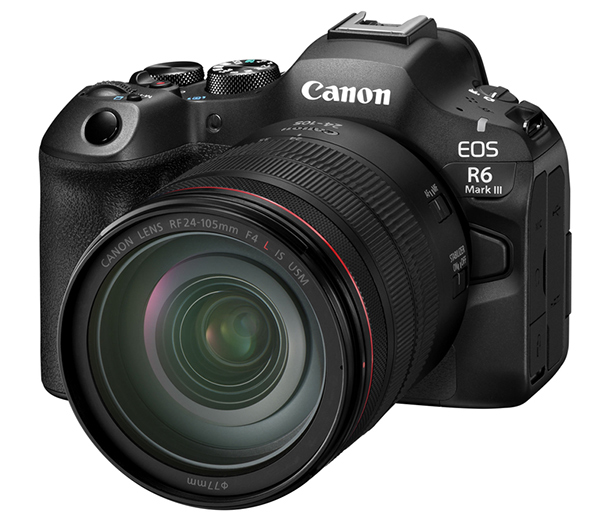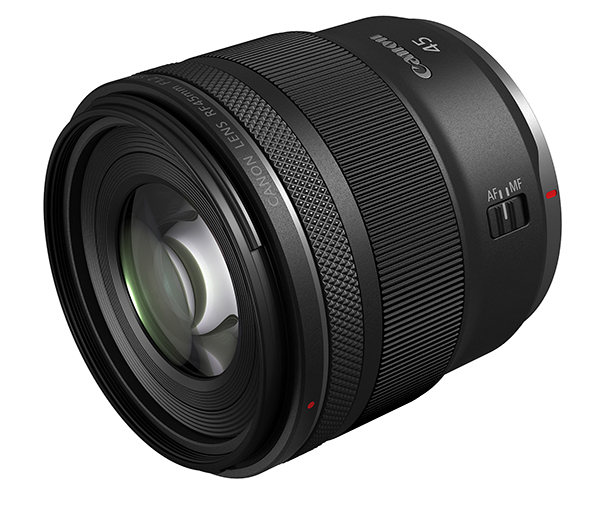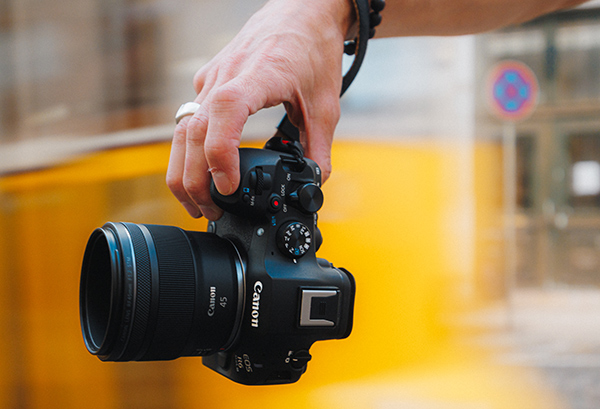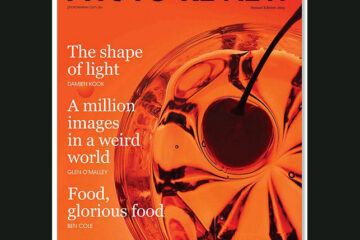Late this month will see the release of Canon’s anticipated, third-generation EOS R6 Mark III full-frame camera along with the lightweight and versatile RF 45mm f/1.2 STM lens.

Angled view of the new Canon EOS R6 Mark III, fitted with the RF 24-105mm f4/L IS USM lens that will be bundled with the camera body as a kit. (Source: Canon.)
Physically, the EOS R6 Mark III is almost identical to its predecessor, with only minor cosmetic changes and a slight increase in weight (to 699 grams vs 670 grams in the Mark II). However, it boasts an increase in resolution from 24.2 megapixels in the Mark II to 32.5 megapixels, suggesting it has the same sensor as the recently-released Cinema EOS C50. Not surprisingly, it uses the same DIGIC X processor as its predecessor, rather than that camera’s more video-orientated DIGIC DV7 chip. These features make the EOS R6 Mark III a genuine ‘hybrid’ camera with powerful stills and advanced filmmaking features, customisable controls and weather-resistant sealing. For both applications, low-light shooting is facilitated by an ISO range that extends from 100 up to 64,000 and delivers clean, detailed images in challenging conditions. (Extensions to ISO 50 and ISO 102400 are available, as in the EOS R6 II.) In-camera crop modes provide an effective extension in reach for wildlife and sports close-ups. In addition, up to 8.5 stops of combined image stabilisation is available at the centre of the frame and 7.5 stops at the edge with compatible lenses. For better organisation and security, instead of the R6 II’s twin SD card slots the new camera has one slot devoted to fast and high-capacity CFexpress Type B cards and the other to UHS-II SD.
Still images can be recorded in the same JPEG, HEIF, CR3.RAW and C-RAW formats as before and the camera supports the same continuous shooting speed of up to 40 fps. However, its expanded buffer memory can accommodate up to 150 RAW images in a single burst (when using CFexpress cards), compared with a maximum of 40 in the R6 II. The R6 III also has an improved pre-recording mode that can capture 20 frames before the shutter is pressed in full RAW, JPEG or HEIF with the H+ mode. Dual Pixel CMOS AF II technology underpins fast, high-precision AF, which has 1053 selectable zones. The hybrid (CD/PD) AF algorithms utilise deep learning to provide subject detection and tracking for people (Eye/Face/Head/Body), animals (Dogs/Cats/Birds/Horses) and vehicles (Cars & Motorbikes). Up to 10 faces can be stored in the camera for AF recognition. Focus bracketing is supported with in-camera depth compositing and the 384-zone metering system has a range of 3-20 EV. Shutter speeds are unchanged and range from 30 seconds to 1/8000 second with the mechanical shutter, reaching a maximum of 1/16000 second when the electronic shutter is used.
For video work, the R6 Mark III features higher resolution with 7K movie recording plus proxy recording at Full HD resolution, along with 24-bit audio for soundtracks, much like the C50. It also provides Open Gate recording, which captures the entire sensor’s output to enable more flexibility in framing, stabilisation, and post-processing. RAW Video is supported and users can choose between XF-HEVC S, H.265, MPEG-4 AVC and H.264 codecs, Long GOP and All-I video compression methods and also record in the following formats: 4K DCI (4096 x 2160) and UHD (3840 x 2160), Full HD (17:9 or 16:9) or oversampled 4K with full sensor readout. Canon Log-2 and Canon Log-3 profiles are available, a step up from the previous model. Interval recording for time-lapse is available with 4K and Full HD recording modes. Full HD 180 fps recording is also available for creative slow-motion effects.
The EOS R6 Mark III introduces a range of new and improved features that also support a smarter, faster workflow. Dual aspect markers show frames for multiple platforms in one shot, while a redesigned control tab offers a customised shooting experience. Quick and secure file transfers are also guaranteed with built-in wireless connectivity and support for the latest 5 GHz Wi-Fi5 and Bluetooth 5.1. Like its predecessor, the R6 III can also be used for video conferencing and live streaming when connected to a computer via USB.

Angled view of the RF 45mm f/1.2 STM lens, shown without end caps or the bundled lens hood. (Source: Canon.)
Launched concurrently with the EOS R6 Mark III, the new RF 45mm f/1.2 STM lens, Canon’s first f/1.2 aperture non-professional RF lens. Designed for photo enthusiasts and affordably priced with an RRP of AU$699, it is equally suitable for stills and movie shooting. This lens is not stabilised but its separate focus and control rings make it a good choice for hybrid storytellers. The optical design of this lens contains nine elements in seven groups and includes Super Spectra coating to suppress ghosting and flare. A nine-bladed iris diaphragm combines with the fast f/1.2 maximum aperture and minimum focusing distance of 45cm to enable images to be recorded with a shallow depth of field and attractive bokeh. The lens weighs 346 grams and features a durable metal mount plus compatibility with Canon’s focus breathing correction technology. Approximately 75mm long with a maximum diameter of 78mm, it accepts 67 mm filters. Canon’s STM (stepping motor) AF technology ensures fast autofocusing. The lens is supplied with front and end caps plus the ES-73B lens hood and LP1116 lens pouch.

This illustration shows the RF 45mm f/1.2 STM lens on the EOS R6 Mark III camera body. (Source: Canon.)
The EOS R6 Mark III and RF 45mm f/1.2 STM are scheduled to be available in Australia from late November 2025. Both are supported by Canon Australia’s 5-year warranty when purchased from an authorised Canon Australia reseller. EOS R6 Mark III has an RRP of $4,299 and the RF 45mm f/1.2 STM of $699. The EOS R6 Mark III and RF 24-105mm f4/L IS USM kit is scheduled for release at the same time at an RRP of $6149. Click here to visit the product page for the EOS R6 III and here for the RF 45mm f/1.2 STM lens.






